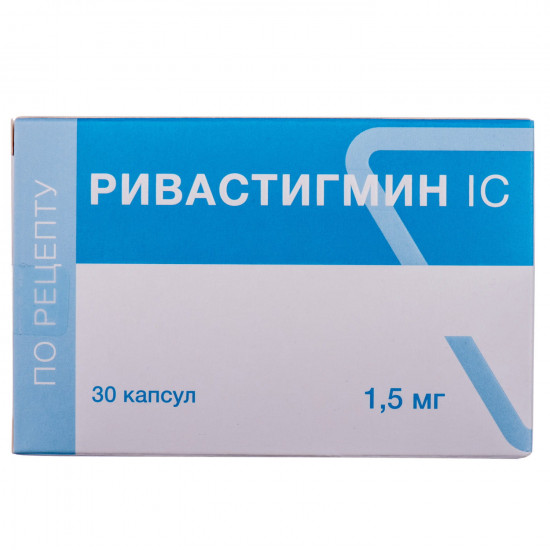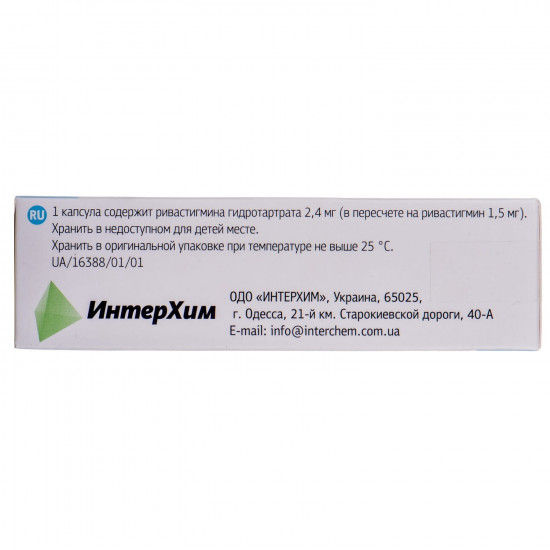



- Stock: In Stock
- Model: 184381
0% Customers recommend this product
-
5 Awesome0%
-
4 Great0%
-
3 Average0%
-
2 Bad0%
-
1 Poor0%
Reviews Over Rivastigmin IC kaps. 1.5 mg No. 30
- (0)
Total Reviews (0)
click here write review to add review for this product.
Report this review.
Description
Pharmacological properties
Pharmacodynamics. rivastigmin is inhibitor of acetylcholinesterase and butyrylcholinesterase of carbamate type which promotes cholinergic neurotransmission, slowing down degradation of acetylcholine which is released by functionally intact cholinergic neurons. thus, rivastigmin renders favorable effect on the cognitive deficit caused by disturbances of cholinergic neurotransmission in dementia associated with Alzheimer's disease or Parkinson's disease.
Rivastigmin interacts with enzymes targets with formation of covalent complexes, temporarily inactivates enzymes targets. At healthy men of young age the oral administration of a dose of 3 mg reduces activity of acetylcholinesterase in SMZh approximately by 40% during the first 1.5 h after administration of drug. After achievement of the maximum inhibiting effect the activity of enzyme is restored to initial level approximately in 9 h. Patients with Alzheimer's disease have a suppression of activity of acetylcholinesterase rivastigminy in SMZh had dose-dependent character (in the studied range of doses to the dose of 6 mg 2 times a day). Suppression of activity of butyrylcholinesterase in SMZh of patients with Alzheimer's disease who received rivastigmin was similar to suppression of activity of acetylcholinesterase.
Pharmacokinetics
Absorption. Rivastigmin is quickly and completely absorbed. With max in blood plasma it is reached approximately in 1 h. Because of interaction of a rivastigmin with enzyme target at increase in a dose the bioavailability increases 1.5 times more than expected. Absolute bioavailability of a rivastigmin after reception in a dose of 3 mg — about 36±13%. At reception of a rivastigmin with food its absorption (time of achievement of the maximum concentration slows down (t max ) increases for 90 min.), decreases With max , AUC approximately increases by 30%.
Distribution. Linking of a rivastigmin with proteins makes about 40%. It easily gets through GEB. The imaginary volume of distribution is 1.8-2.7 l/kg of body weight.
Metabolism. Rivastigmin is quickly and intensively metabolized (T ½ from blood plasma — about 1 h) generally by hydrolysis with participation of cholinesterase with formation of a dekarbamilirovanny metabolite. In vitro this metabolite slightly inhibits acetylcholinesterase (10%).
According to the data obtained in the researches in vitro pharmacokinetic interactions with medicines which are metabolized by the following isoforms of P450 cytochrome (CYP) are not expected: CYP 1A2, 2D6, 3A4/5, 2E1, 2C9, 2C8, 2C19 or 2B6. According to researches on animals the main isoenzymes of P450 cytochrome participate in metabolism of a rivastigmin in the minimum degree. The general clearance of a rivastigmin in/in introductions in a dose of 0.2 mg was later about 130 l/h, after introduction in a dose of 2.7 mg decreased to 70 l/h
Removal. Rivastigmin in not changed look in urine is not revealed; the main way of discharge — kidneys in the form of metabolites. After introduction l4 C-rivastigmina discharge was kidneys fast and almost full (90%) during 24 h. Less than 1% of a dose are removed with a stake. At patients with Alzheimer's disease the accumulation of a rivastigmin or its dekarbamilirovanny metabolite is not revealed.
according to the population pharmacokinetic analysis at patients with Alzheimer's disease the intake of nicotine increases clearance of a rivastigmin at oral administration in a dose to 12 mg/days for 23%.
Special groups of patients
Patients of advanced age. Though the bioavailability of a rivastigmin at elderly people is higher, than at healthy volunteers of young age, however in researches with participation of patients with Alzheimer's disease aged from 50 up to 92 years did not reveal any changes of bioavailability connected with age.
Patients with an abnormal liver function. At patients with an abnormal liver function easy or moderate severity With max rivastigmina was about 60% higher, and AUC — by ≥2 times in comparison with healthy volunteers.
Patients with a renal failure. Patients with a renal failure of moderate severity have a value With max and AUC of a rivastigmin were higher at the ≥2nd time, than at healthy volunteers; however changes of values With max and AUC of a rivastigmin at patients with a renal failure of heavy degree is not established.
Indication
Symptomatic treatment of dementia from easy to the moderate severity caused by Alzheimer's disease.
Symptomatic treatment of dementia from easy to moderate severity at patients with idiopathic Parkinson's disease.
Use
Treatment should be begun and carried out byunder observation of the doctor having experience of diagnostics and treatment of dementia in the Alzheimer's disease or dementia caused by Parkinson's disease and under observation of persons who will regularly control medicine use by the patient.
Route of administration. The medicament is taken inside, during meal, 2 times a day — in the morning and in the evening. To swallow the capsule entirely, without chewing.
Recommended dosing mode
Initial dose and doses of titration. An initial dose — 1.5 mg 2 times a day.
byIf after at least 2 weeks of treatment notes good tolerance of an initial dose, it is possible to raise a dose to 3 mg 2 times a day. Perhaps further increase in a dose to 4.5 mg 2 times a day and then up to 6 mg 2 times a day at good tolerance of the previous dose with time interval not less than 2 weeks after each previous increase in a dose.
byIf at patients with dementia caused by Parkinson's disease observe side reactions (for example nausea, vomiting, an abdominal pain or loss of appetite), degrowth of a body or deterioration in extrapyramidal disorders (for example a tremor), it is possible to try to pass one or several doses. If side reactions do not disappear, it is necessary to lower temporarily a dose to the previous dose which was well transferred, or to stop treatment.
Maintenance dose and termination of treatment. The recommended effective dose makes from 3 to 6 mg 2 times a day. It is necessary to apply the highest dose which is well transferred by the patient to achievement of the maximum advantage of treatment. The recommended maximum dose — 6 mg 2 times a day.
Supporting treatment can be continued byuntil there is an advantage of treatment for the patient. So, it is regularly necessary to carry out the assessment of advantage of treatment rivastigminy, especially at the persons receiving a dose 2 times a day is lower than 3 mg. If in 3 months of maintenance therapy the improvement of a condition of the patient is not observed, treatment should be stopped. Besides, it is necessary to consider the possibility of the termination of therapy if signs of therapeutic effect are not observed any more.
Individual reaction on rivastigmin cannot be predicted. However the best effect of treatment was observed at patients with dementia of the average degree associated with Parkinson's disease. Also the best effect was observed at the patients with Parkinson's disease who had visual hallucinations.
Placebo-controllable researches lasting more than 6 months for the purpose of studying efficiency of a rivastigmin were not conducted.
therapy Resuming. If having rummaged in administration of medicament made more than 3 days, it is necessary to resume treatment from a dose of 1.5 mg 2 times a day. Then it is necessary to carry out titration of a dose as it is described above.
Patients with dysfunction of kidneys/liver. With dysfunction of kidneys/liver of light or moderate severity of dose adjustment of a rivastigmin it is not required to patients. However because of increase in exposure of a rivastigmin at these patients it is necessary to titrate carefully a medicament dose taking into account individual shipping of treatment as at patients with clinically apparent dysfunction of kidneys/liver perhaps more frequent development of dose-dependent side reactions. Use of a rivastigmin for patients with an abnormal liver function of heavy degree was not investigated (see CONTRAINDICATIONS).
Contraindication
Hypersensitivity to a rivastigmin, other derivatives of a carbamate or to any other component of drug. period of pregnancy and feeding by a breast. children's age (up to 18 years).
toMedicine is contraindicated to patients with abnormal liver functions of heavy degree due to the lack of data on efficiency and safety of use for such patients of a rivastigmin.
toSide effects
byit was Most often reported about side effects from a digestive tract, including nausea (38%) and vomiting (23%), especially during titration of a dose. according to clinical trials the undesirable reactions from a GIT and degrowth of a body noted at women more often, than at men.
side Below-mentioned reactions are distributed byon frequency as follows: very often (≥1/10), it is frequent (≥1/100 up to 1/10), infrequently (≥1/1000 up to 1/100), is rare (≥1/10,000 up to 1/1000) and is very rare (1/10,000), it is unknown (frequency cannot be estimated on the available data).
At patients with dementia caused by Alzheimer's disease at treatment rivastigminy were noted by the following side reactions:
from nervous system: very often — dizziness; often — a headache, drowsiness, a tremor; infrequently — faints; seldom — spasms; very seldom — extrapyramidal disturbances (including deterioration in a course of the accompanying Parkinson's disease).
Mental disturbances: often — dreadful dreams, agitation, confusion of consciousness, alarm; infrequently — insomnia, a depression; very seldom — hallucinations; it is unknown — aggression, concern.
from digestive system: often — nausea, vomiting, diarrhea; often — an abdominal pain and dyspepsia; seldom — stomach ulcer and a duodenum; very seldom — gastrointestinal bleeding, pancreatitis; it is unknown — some cases of heavy vomiting were connected with a rupture of a gullet (see. Special INSTRUCTIONS).
from a gepatobiliarny system: seldom — increase in laboratory indicators of function of a liver; it is unknown — hepatitis.
from a metabolism: often — anorexia; often — a loss of appetite; it is unknown — dehydration.
from a cardiovascular system: seldom — stenocardia; very seldom — arrhythmias (including bradycardia, blockade, fibrillation of auricles and tachycardia), AG.
from skin and hypodermic cellulose: often — a hyperhidrosis; seldom — rash, it is unknown — an itching, allergic dermatitis (disseminate).
Infection and invasion: very seldom — infections of urinary tract.
General disturbances: often — increased fatigue and an asthenia, an indisposition; infrequently — accidental falling.
Results of researches: often — degrowth of a body.
At patients with dementia caused by Parkinson's disease at treatment rivastigminy were noted by the following side reactions:
from nervous system: very often — a tremor; often — dizziness, drowsiness, a headache, deterioration in the course of the disease of Parkinson, a bradykinesia, dyskinesia, a hypokinesia, rigidity as "cogwheel"; infrequently — dystonia.
Mental disturbances: often — insomnia, alarm, concern, visual hallucinations, a depression; it is unknown — aggression.
from digestive system: very often — nausea, vomiting, it is frequent — diarrhea, an abdominal pain and dyspepsia, hypersalivation.
from a gepatobiliarny system: it is unknown — hepatitis.
from a cardiovascular system: often — bradycardia, AG; infrequently — fibrillation of auricles, AV blockade; it is unknown — a sick sinus syndrome, arterial hypotension.
from a metabolism: often — a loss of appetite, dehydration.
from skin and hypodermic cellulose: often — a hyperhidrosis; it is unknown — allergic dermatitis (disseminate).
General disturbances: very often — accidental falling; often — increased fatigue and an asthenia, disturbance of gait, parkinsonichesky gait.
Special instructions
Frequency of development and weight of side reactions usually increase with increase in a dose of a rivastigmin. if having rummaged in administration of medicament made more than 3 days, it is necessary to resume treatment from a dose of 1.5 mg 2 times a day for reduction of risk of emergence of side reactions (for example vomiting) (see use).
Titration of a dose. Through short time after increase in a dose at patients with dementia in Alzheimer's disease noted such side reactions as AG and hallucinations, persons with dementia in Parkinson's disease have extrapyramidal disturbances, especially a tremor. If at a dose decline the expressiveness of side reactions did not decrease, treatment rivastigminy was stopped (see. Side EFFECTS).
Degrowth of a body. As at patients with Alzheimer's disease against the background of therapy by cholinesterase inhibitors, including rivastigmin, degrowth of a body is possible, it is necessary to control the body weight of patients during treatment rivastigminy.
Reaction from skin. It was reported about exceptional cases of development of allergic dermatitis (disseminated) at use rivastigmin irrespective of a route of administration (inside or transdermalno). In these cases the treatment rivastigminy should be cancelled (see CONTRAINDICATIONS). The patients and persons who are looking after them have to be informed on a possibility of development of reactions from skin at use of a rivastigmin.
Disturbance from digestive system. Side reactions from a GIT, such as nausea, vomiting and diarrhea, dozozavisima can also arise especially in an initiation of treatment and/or at increase in a dose (see. Side EFFECTS). These side reactions note at women more often. In the heavy vomiting connected with treatment rivastigminy the corresponding dose adjustment is recommended (see USE). Some cases of heavy vomiting were connected with a rupture of a gullet (see. Side EFFECTS). Such cases noted especially after increase in a dose or use of a rivastigmin in high doses. It is recommended to patients at whom manifestations of dehydration owing to long vomiting or diarrhea developed in/in input of the fluid and a dose decline or the termination of therapy rivastigminy. Dehydration can be connected with serious consequences.
Rivastigmin can strengthen secretion of hydrochloric acid in a stomach. It is necessary to be careful at use of a rivastigmin for patients with ulcer of stomach or duodenum in a stage of aggravation or at the persons inclined to these states.
Disturbance from a cardiovascular system. Mainly with risk factors rivastigmin can cause bradycardia which is risk factor of developing of ventricular tachycardia on type a pirouette (torsades de pointes) in patients. It is necessary to be careful at use of a rivastigmin for patients with high risk of developing piruetny tachycardia, in particular to the persons with dekompensirovanny heart failure which are recently postponed a myocardial infarction with bradyarrhythmia, tendency to a hypopotassemia or a hypomagnesiemia, the patients who are combined applying the medicines causing prolongation of a Q-T-interval and/or torsades de pointes (see INTERACTIONS, SIDE EFFECTS).
Should be careful at use of a rivastigmin for patients with a sick sinus syndrome or disturbances of conductivity (sinoauricular block, blockade) (see. Side EFFECTS).
Other undesirable phenomena. Patients should appoint inhibitors of cholinesterase with care with OH or obstructive disease of lungs in the anamnesis. Cholinomimetics can induce or strengthen obstruction of urinary tract and a spasm. At treatment of patients it is necessary to be careful with these pathologies.
Use of a rivastigmin for patients with heavy dementia in Alzheimer's disease or in Parkinson's disease, with other types of dementia or other types of disturbances of memory (for example with age decrease in cognitive function) was not investigated therefore use of medicament for patients of these groups is not recommended.
As well as in case of other cholinomimetics, at use of a rivastigmin the emergence or strengthening of expressiveness of extrapyramidal disturbances is possible.
At patients with dementia associated with Parkinson's disease were noted by motive disturbances (including a bradykinesia, dyskinesia, disturbance of gait) and increase in expressiveness of a tremor (see. Side EFFECTS). In certain cases because of these phenomena it was necessary to stop therapy rivastigminy (namely: frequency of cases of medicament withdrawal because of a tremor was 1.7% in group of a rivastigmin against 0% — in group of placebo). Clinical monitoring of these undesirable reactions is recommended.
Special groups of patients
At patients with clinically apparent dysfunction of kidneys/liver perhaps more frequent development of dose-dependent undesirable reactions (see. Pharmacological PROPERTIES, USE). It is recommended to titrate carefully a dose taking into account individual shipping of treatment by patients of this group. Use of a rivastigmin for patients with an abnormal liver function of heavy degree was not investigated (see CONTRAINDICATIONS).
At patients with the body weight of 50 kg perhaps more frequent development of undesirable reactions that can lead to the treatment termination.
Use during pregnancy and feeding by a breast
Pregnancy. By results of the conducted researches with participation of pregnant animals rivastigmin and its metabolites crossed a placental barrier. The potential risk for people is unknown. Data on use of a rivastigmin for people during pregnancy are absent. In researches on rats pre- and post-natal development of posterity noted lengthening of the period of pregnancy. Rivastigmin it is not necessary to apply during pregnancy without emergency.
Feeding by a breast. According to the conducted researches rivastigmin got into breast milk of animals in the period of a lactation. Data on penetration of a rivastigmin into breast milk at the person are absent. The women applying rivastigmin should not nurse.
Fertility. According to the research of influence of a rivastigmin on fertility or reproductive function of animals conducted on rats it was not observed. Data on influence of a rivastigmin on fertility at the person are absent.
Children. Drug is not used at children (aged up to 18 years) due to the lack of data on use of a rivastigmin for patients of this age group.
Ability to influence speed of response at control of vehicles or work with other mechanisms. Alzheimer's disease can lead to gradual deterioration in ability to run vehicles or to threaten a possibility of control of mechanisms. Besides, rivastigmin can cause dizziness and drowsiness, especially in an initiation of treatment and at increase in a dose. So, rivastigmin has insignificant or moderate influence on ability to run vehicles or to work with other mechanisms. The ability of the patients with dementia applying rivastigmin to continue to run vehicles or to work with mechanisms should be estimated regularly the doctor.
Interaction
As cholinesterase inhibitor rivastigmin can enhance effects of muscle relaxants of suktsinilkholinovy type during anesthesia. it is necessary to be careful when choosing anesthetic. if necessary it is possible to consider a question of a korrigirovaniye of a dose or the temporary termination of treatment.
Considering pharmakodinamichesky effects of a rivastigmin and its possible additive effects rivastigmin it is not necessary to apply combined with other cholinomimetics. Rivastigmin can reduce therapeutic effect of anticholinergic medicines (for example an oksibutinina, a tolterodina).
toIt was reported about additive effects which led to bradycardia (with risk of development to a syncope), at the combined use of a rivastigmin and various blockers of β-adrenoceptors (including atenolol). In spite of the fact that use of a rivastigmin with cardioselective blockers of β-adrenoceptors is connected with high risk of development of such effects, the specified side effects noted also at the patients applying other medicines of group of blockers of β-adrenoceptors. Therefore it is necessary to show care at use of a rivastigmin in a combination with blockers of β-adrenoceptors and other medicines which can cause bradycardia (for example antiarrhytmic medicaments III of a class, antagonists of calcium channels, foxglove glycosides, pilocarpine).
As bradycardia is risk factor of developing ventricular tachycardia on type a pirouette (torsades de pointes), it is necessary to be careful and to carefully monitorirovat the state of health of the patient (ECG) at use of a rivastigmin in a combination with medicines which can provoke tachycardia on type a pirouette, such as antipsychotic means, for example some fenotiazina (Chlorpromazinum, levomepromazinum), benzamides (Sulpiridum, sultoprid, amisulprid, tiaprid, veraliprid), Pimozidum, a haloperidol, Droperidolum; tsizaprid; to tsitalopra; difemanit; erythromycin (in / c), moxifloxacin; galofantrin, pentamidine; mizolastin; methadone.
byAt healthy volunteers of pharmacokinetic interaction between rivastigminy and digoxin, warfarin, diazepam or fluoxetine it is not revealed. Use of a rivastigmin does not influence the increase in a prothrombin time caused by warfarin. At simultaneous use of digoxin and a rivastigmin of undesirable influence on the carrying-out system of heart it is not revealed.
Considering that metabolism of a rivastigmin with participation of the main isoenzymes of P450 cytochrome (CYP) is carried out in the minimum degree, pharmacokinetic interactions of a rivastigmin with other medicines which are metabolized with participation of CYP, are improbable. Though rivastigmin can suppress metabolism of medicines which biotransformirutsya with butyrylcholinesterase participation.
Overdose
Symptoms. the accidental overdose in most cases was not followed by any clinical manifestations, and almost all patients continued treatment rivastigminy in 24 h after overdose.
In poisonings of moderate severity with inhibitors of cholinesterase such muskarinovy effects as a miosis, face reddening, digestion disturbance (including an abdominal pain, nausea, vomiting and diarrhea) noted, bradycardia, a bronchospasm and increase in bronchial secretion, a hyperhidrosis, involuntary urination and/or defecation, dacryagogue, arterial hypotension, hypersalivation. In case of more serious poisoning inhibitors of cholinesterase development of such nicotinic effects as muscle weakness, fastsikulyation, spasms, an apnoea with a possible lethal outcome is possible.
toit was Also reported about cases of dizziness, a tremor, a headache, drowsiness, psychosis, arterial hypertension, hallucinations and indispositions.
Treatment. As the rivastigmina makes T ½ blood plasma about 1 h, and acetylcholinesterase inhibition duration — about 9 h, in cases of asymptomatic overdose the reception of the following dose of a rivastigmin during the following 24 h is not recommended. If the overdose is followed by the profound nausea and vomiting, it is necessary to consider the possibility of use of antiemetics. In case of other undesirable phenomena if necessary it is necessary to perform the corresponding symptomatic therapy.
At the significant overdose can apply atropine. The initial dose of Atropini sulfas of 0.03 mg/kg with the subsequent increase depending on the clinical answer is recommended. Use of Scopolaminum as antidote is not recommended.
Storage conditions
In original packing at a temperature not above 25 °C.
Specifications
| Characteristics | |
| Active ingredients | Rivastigmin |
| Amount of active ingredient | 1.5 mg |
| Applicant | Interkhim |
| Code of automatic telephone exchange | N06DA03 Rivastigmin |
| Interaction with food | It doesn't matter |
| Light sensitivity | Not sensitive |
| Market status | Generic-generic |
| Origin | Chemical |
| Prescription status | According to the prescription |
| Primary packing | blister |
| Producer | INTERKHIM ODO |
| Quantity in packing | 30 capsules (3 blisters on 10 pieces) |
| Release form | capsules for internal use |
| Route of administration | Oral |
| Sign | Domestic |
| Storage temperature | from 5 °C to 25 °C |
| Trade name | Rivastigmin |











































